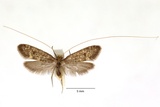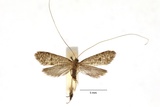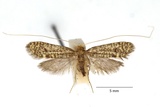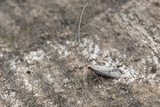Nematopogon robertella (Clerck, 1759) Species
Last modified: Feb. 20, 2024, 4:07 p.m.
A fairly common species in Belgium, widely distributed.
Details
- Classification
- Family: Adelidae > Subfamily: Nematopogoninae > Genus: Nematopogon > Species: Nematopogon robertella
- Vernacular names
- Naaldboslangsprietmot (NL), Heidelbeer-Langhornmotte (DE)
- Synonyms
- Nematopogon pilulella (Hübner, 1813)
- First mention in Belgium
- Janmoulle E. 1954a. Espèces nouvelles pour la faune belge (suite). — Lambillionea 54: 3–4, 33–34, 57–58. On page 4.
- Status
-
Native
Distribution
Caterpillar
Greyish white skin; the former 6–7 abdominal segments reddish-brown; head black, thoracic plates darb brown.
Case
8–10 mm, constructed from 4 to 6 crescent-like plant particles.
Bionomics
Details about the oviposition and the early larval stages are still unknown. Cases found during autumn containing less than five crescents contain caterpillars that will hibernate and will continue feeding for a second year. Cases with five or sex crescents contain fully-grown larvae that will hibernate in the larval stage and pupate in springtime without further feeding.
The adult moths are active in late afternoon sunshine and at dusk. They come to light.
Flight periods
The adults fly in one generation a year from mid-May till mid-July.
Observed on
- Substrates:
- Dead leaves and Detritus
The larva lives on detritus, but also on fresh leaves of lower plants, like Vaccinium myrtillus. It also has been observed feeding on the needles of pine trees.
Habitat
Mixed forests or pure pine forests with mainly Abies alba or Picea abies, mainly in cool habitats.






